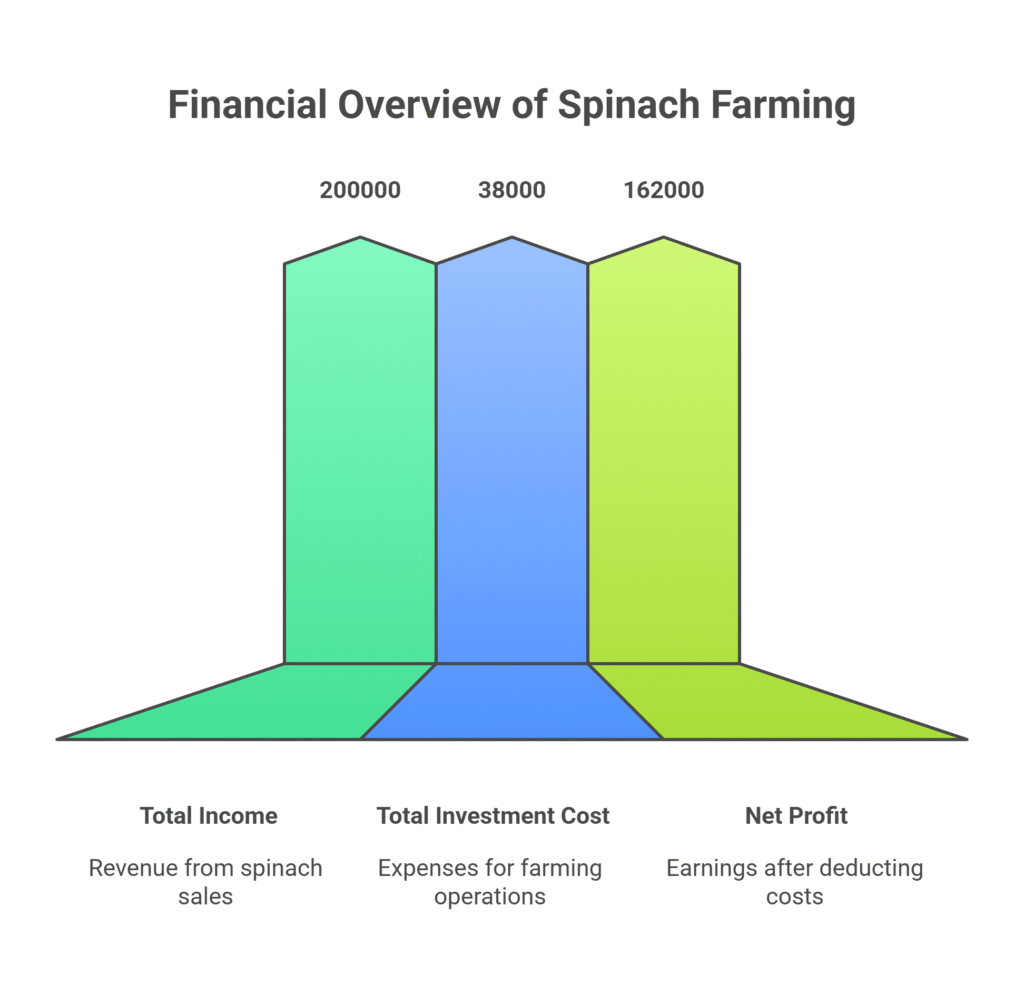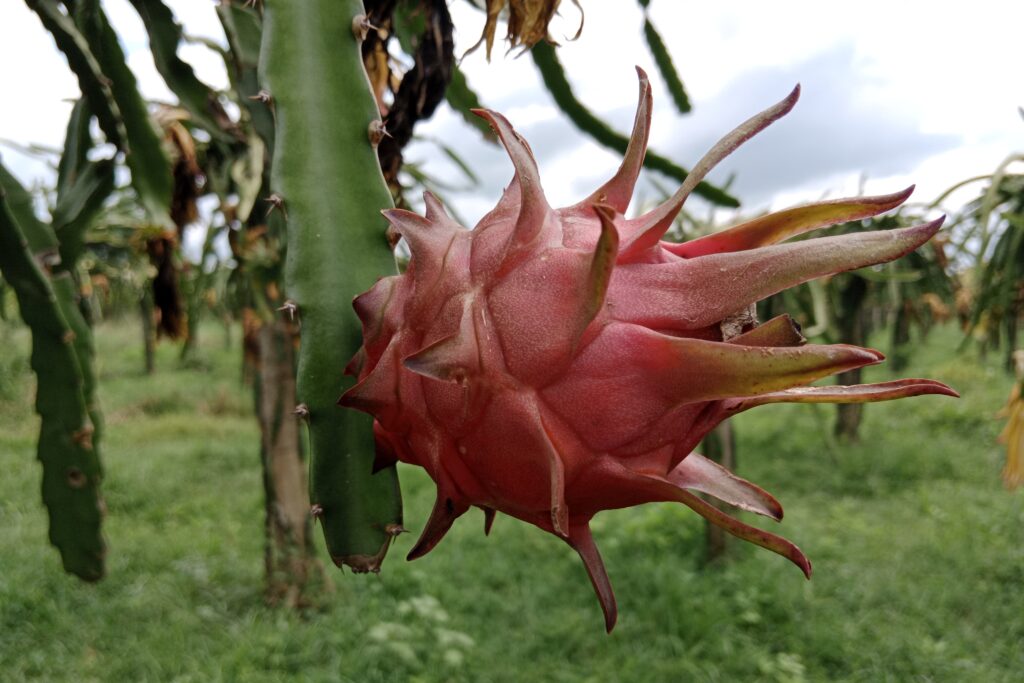Spinach Farming
Spinach farming profit per acre demonstrates strong viability, with an estimated total income of 200,000 NRs generated from a yield of 10,000 kg of fresh leaves sold at 20 NRs/kg. After accounting for the total investment cost of 38,000 NRs (covering land preparation, seeds, labor, inputs, and harvesting), the net profit stands at 162,000 NRs per acre, highlighting its potential as a financially rewarding agricultural venture under these conditions.
Land Preparation
The goal of land preparation for spinach farming is to establish a seedbed that is fine, weed-free, and well-drained. To completely loosen the soil, this entails tilling or deep plowing it to a depth of 8 to 12 inches. To increase fertility at this point, the soil should be mixed with compost or well-rotted farmyard manure (FYM). A smooth, flat surface is created by breaking up clods with the aid of subsequent harrowing and leveling. Since spinach is extremely susceptible to waterlogging, proper drainage is crucial.
Soil Type
While spinach thrives best in deep, fertile loamy soils rich in organic matter, it can also grow in sandy or clay loam soils if they are well-drained. The ideal soil pH for spinach is between 6.0 and 7.0, which falls within the slightly acidic to neutral range. Deviations from this range, especially pH levels above 7.5, may lead to nutrient deficiencies such as a lack of manganese, while very low pH can cause toxicities.
Climatic Requirements
| Climatic Requirement | Details |
| Type | Cool-season crop |
| Optimal Temperature | 10°C to 24°C (50°F to 75°F); tolerates light frost; growth slows above 24°C |
| Bolting Trigger | High temperatures (especially above 26°C/79°F) and long daylight hours cause premature flowering (bolting), resulting in bitter leaves and reduced quality. Selecting suitable cultivars is important for warm-season growth. |
| Light Requirement | Prefers full sun but tolerates partial shade, especially in warmer conditions |
Major Cultivars
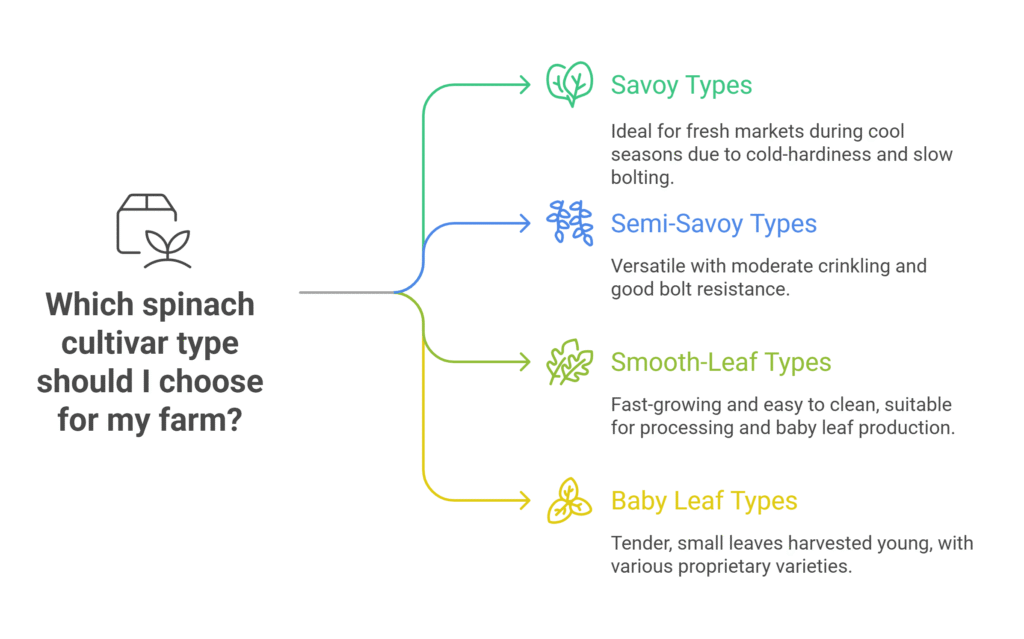
| Cultivar Type | Characteristics | Examples |
| Savoy Types | Crinkly, dark green leaves; cold-hardy; slower to bolt; ideal for fresh markets during cool seasons | Bloomsdale, Regiment |
| Semi-Savoy Types | Moderately crinkled leaves; good bolt resistance; versatile for various uses | Tyee, Catalina |
| Smooth-Leaf Types | Broad, smooth leaves; easy to clean; fast-growing; commonly used for processing (canning, freezing) and baby leaf production; more sensitive to bolting | Space, Red Kitten |
| Baby Leaf Types | Selected for tender, small leaves harvested at a young stage; includes various leaf types | Many proprietary varieties |
| Selection Criteria | Choose cultivars based on season (bolt resistance is important in warm climates), market demands (savoy vs. smooth), and disease resistance | — |
Seed Rate per Acre
Optimal spinach seed rates are 4–6 kg/acre in winter. Because summer heat reduces germination, a higher rate of 8–12 kg/acre is recommended. Pre-soaking seeds in water for 12 to 24 hours also helps increase germination success.
Planting
a). Planting Season
Spinach grows throughout the year. Sow seeds from September to October for winter harvest, and from mid-February to April for spring harvest
b). Spacing
For optimal spinach growth, maintain a spacing of 30 cm between rows and thin the plants within rows to a distance of 10 cm after germination to ensure adequate space for healthy development.
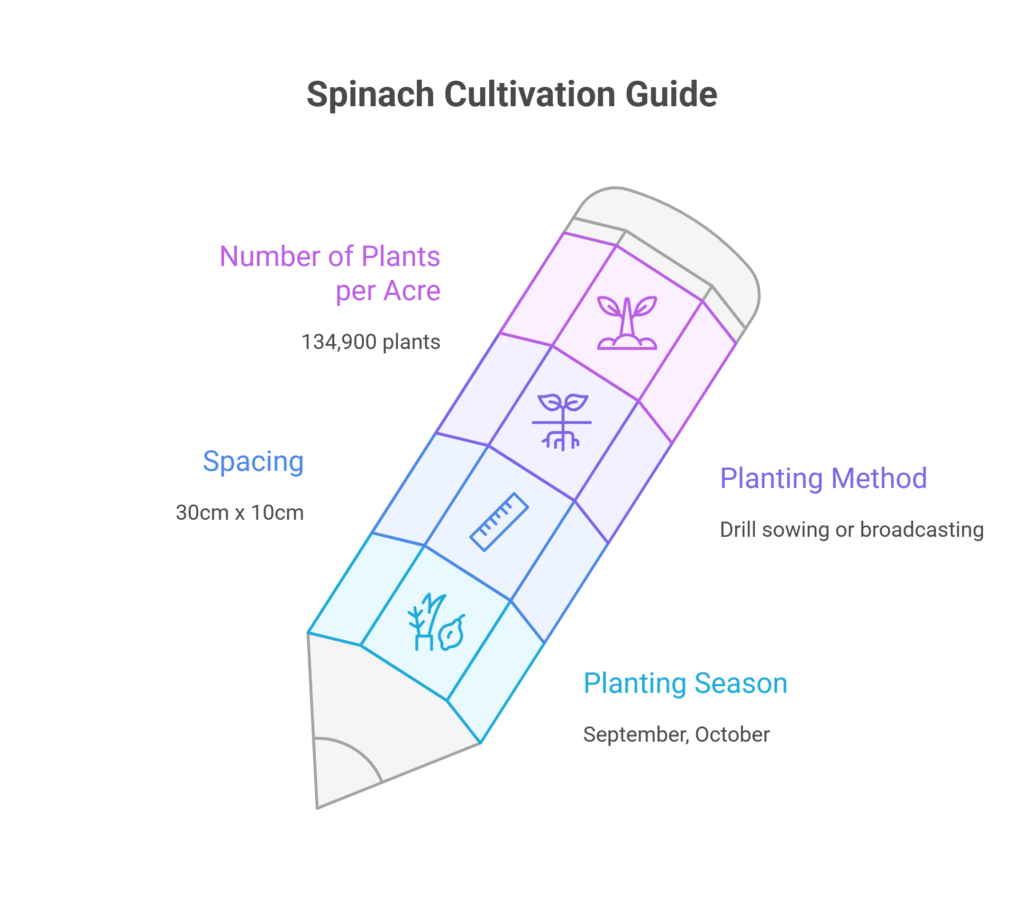
c). Planting Method
Direct seeding is the most common method for spinach cultivation. Drill sowing, where seeds are placed in furrows 1–2 cm deep and lightly covered with soil, is the most efficient and widely used technique. Alternatively, broadcast sowing involves scattering seeds evenly over the bed and lightly raking them in, though it requires a higher seed rate and subsequent thinning. This method is occasionally used for baby leaf spinach production.
d). Number of Plants per Acre:
Based on the spacing of 30 cm between rows and 10 cm within rows, approximately 134,900 plants can be accommodated per acre.
Intercropping
Spinach is well-suited for intercropping, particularly with slower-growing vegetables such as cabbage, cauliflower, tomatoes, or peppers, as well as compatible companions like onions, garlic, or strawberries. This practice offers significant advantages: it maximizes space and land efficiency, helps suppress weeds, and can provide pest management benefits.
Spinach’s rapid growth cycle makes it an excellent “catch crop” that utilizes space before the main crop matures. However, careful consideration is essential to ensure adequate spacing and light reach all plants, while also preventing excessive competition for water and nutrients between the spinach and its companion crops.
Irrigation
Spinach requires consistent moisture for tender growth and bolt prevention, due to its shallow roots. Use light, frequent irrigation to keep soil moist (not waterlogged), especially during germination and leaf development. Apply pre-sowing irrigation if needed. Water immediately after sowing, then every 4–6 days in summer or 10–12 days in winter. Avoid over-irrigation and wetting leaves to reduce disease and maintain quality. Drip irrigation is ideal for efficient water delivery and dry foliage, though sprinklers or furrow systems are also used.
Fertilizer and Manure
| Application Type | Component | Quantity per Acre | Timing/Method | Notes |
| Basal Application | FYM or Compost | 10-15 tonnes | During land preparation | Well-rotted |
| Basal Application | Biofertilizer Mix: -Azospirillum – PSB – Potash Mobilizing Bacteria | 1 kg each (Total 3 kg) | Incorporated basally | Phosphorous Solubilizing Bacteria (PSB) |
| NPK (Basal) | Nitrogen (N) (Basal portion) | 17.5 kg | Half applied basally | Total N: 35 kg/acre (Split applications for remaining half) |
| Phosphorus (P₂O₅) | 12 kg | Applied basal | Based on soil test | |
| Potassium (K₂O) | 12 kg | Applied basal | Based on soil test | |
| Top Dressing | Nitrogen (N) (Remaining portion) | 17.5 kg | Split applications post-basal 3-4 weeks after sowing | Critical for leafy growth |
Weed Control
Weed control is crucial in spinach cultivation due to its shallow root system, which makes it highly susceptible to competition from weeds. Effective methods include cultural practices like shallow hoeing between rows and mulching with organic matter or plastic to suppress weed growth. Mechanical control involves hand weeding within the rows. Chemically, two to three hoeings not only help manage weeds but also improve soil aeration. For pre-emergence weed control, Pyrazone should be applied at a rate of 1 to 1.12 kg per acre. However, the use of weedicides should be avoided after this initial application.
Flowering and Fruit Management
Flowering and fruit management in spinach primarily involves preventing premature bolting, which is triggered by high temperatures and long daylight hours. Bolting leads to the development of flower stalks and results in bitter, unpalatable leaves, making the crop unfit for harvest. To manage this, it’s essential to choose bolt-resistant cultivars suited to the season, plant at the appropriate time to avoid heat stress, maintain consistent soil moisture, and minimize overall plant stress. Timely harvesting before bolting begins is also critical. Since spinach is cultivated for its foliage, there is no need for fruit management.
Pest and Disease Management
Common Pests
a). Aphids
Aphids damage spinach by sucking sap and transmitting viruses, leading to stunted growth and yellowed leaves. They can be controlled using insecticidal soap, neem oil, or chemical sprays like Imidacloprid or Acetamiprid at 1 ml per liter of water.
b). Leaf miners
Leaf miners are larvae that tunnel inside leaves, causing visible trails and reducing photosynthesis. Control involves removing infested leaves, using row covers to prevent egg-laying, and spraying specific insecticides like Profenophos + Cypermethrin at 3 ml per liter of water.
c). Flea Beetles
Flea beetles are small, jumping pests that primarily damage young plants by chewing numerous small, round “shot-hole” holes in leaves; this feeding weakens plants, stunts growth, and can significantly reduce yields, especially in seedlings and transplants. Effective management strategies include using physical barriers like floating row covers to exclude the beetles and applying insecticides when necessary to control damaging infestations.
d). Slugs/Snails
Slugs and snails chew holes in spinach leaves, particularly under damp conditions. They can be managed using baits, traps, and maintaining good field sanitation to reduce their habitat.
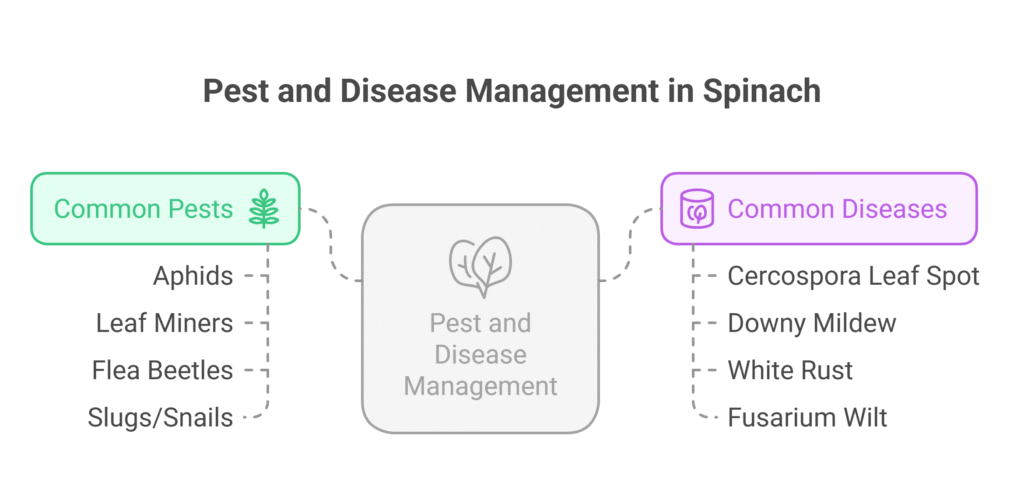
Common Diseases
a). Cercospora Leaf Spot
Cercospora leaf spot appears on spinach leaves as small circular to semi-circular lesions with grey centers and reddish margins. In seed crops, if infestation is detected, it should be managed by spraying Carbendazim or Indofil M-45 at a rate of 400 grams per 150 liters of water per acre. If needed, the spray can be repeated at 15-day intervals for effective control.
Downy Mildew
Downy mildew in spinach is identified by yellow spots on the upper leaf surface and purple mold on the underside. Effective management includes planting resistant cultivars, ensuring good air circulation, avoiding overhead watering, and applying recommended fungicides when necessary.
b). White Rust
The health and marketability of spinach plants are impacted by white rust, which manifests as white pustules on the leaves. Utilizing resistant cultivars, crop rotation to disrupt the disease cycle, and the application of suitable fungicides when necessary are ways to manage it.
c). Fusarium Wilt
A soil-borne illness called fusarium wilt makes spinach plants yellow, wilt, and eventually die. To lessen the pathogen’s presence, management techniques include long-term crop rotation, planting resistant cultivars, and keeping the soil sanitary.
d). Damping-off
Damping-off causes seedling rot at the soil line, leading to poor germination and plant loss. Prevention involves ensuring good soil drainage, avoiding overwatering, and using fungicide-treated seeds to protect young plants.
Harvesting
Spinach harvesting can be done as a bunch harvest at 40–55 days with whole plants cut below the crown, or as baby leaf harvest at 25–35 days by cutting leaves above the crown for multiple picks. Harvest early in the morning using hand tools to ensure crispness and avoid bruising, followed by rapid cooling. The first cut is ready 25–30 days after sowing, with subsequent harvests every 20–25 days depending on variety and season.
Yield
yields typically range from 100 to 200 quintals per acre (about 10 to 20 metric tons per hectare). Baby leaf harvests may have lower weight per cut, but multiple harvests can increase the total yield over time.
Cost of Investment per Acre for Spinach Farming
| S.N. | Category | Cost (NRs) |
| 1 | Land Preparation (plowing) | 15,000 |
| 2 | Seed | 1,000 |
| 3 | Planting | 3,000 |
| 4 | Fertilizers and Manure | 5,000 |
| 5 | Irrigation | 3,000 |
| 6 | Weed Control | 2,000 |
| 7 | Pest & Disease Control | 3,000 |
| 8 | Harvesting | 3,000 |
| 9 | Miscellaneous Costs | 3,000 |
| Total Cost | 38,000 |
Income from Per Acre Spinach Farming
| Particulars | Estimated Yield (kg) | Market Price (NRs/kg) | Total Income (NRs) |
| Fresh Leaves Yield | 10,000 | 20 | 200,000 |
Analysis of Spinach Farming Profit Per Acre
| Metric | Calculation | Amount (NRs) |
| Total Income | 10,000 kg × NRs 20/kg | 200,000 |
| Total Investment | Sum of all costs | 38,000 |
| Net Profit | Income – Investment | 162,000 |
Spinach farming generates a total income of 200,000 NRs per acre from the sale of 10,000 kg of fresh leaves at a market rate of 20 NRs/kg. After deducting the total investment cost of 38,000 NRs (covering land preparation, seeds, labor, inputs, and harvesting), the net profit amounts to 162,000 NRs per acre, demonstrating strong profitability for this crop under the given assumptions.
Crop Calendar for Spinach Farming
| Stage | Activity | Timeframe | |
| 1. Land Preparation | Ploughing, harrowing, and leveling; apply well-rotted FYM | 10–15 days before sowing | |
| 2. Sowing | Direct seeding or transplanting in rows/spaced beds | Oct–Feb (cool season crop) | |
| 3. Germination | Maintain consistent moisture; avoid waterlogging | 5–7 days after sowing | |
| 4. Thinning | Thin seedlings to maintain proper spacing (15–20 cm apart) | 10–15 days after sowing | |
| 5. Irrigation | Light and frequent; especially critical during germination and leaf growth | Every 4–5 days or as needed | |
| 6. Fertilization | Apply nitrogen-rich fertilizers in split doses | Basal at sowing, then every 15–20 days | |
| 7. Weed Management | Shallow hoeing, hand weeding, or use of mulch/herbicide | Start 15 days after sowing; repeat as needed | |
| 8. Pest & Disease Control | Monitor regularly; spray insecticides or fungicides as required | As needed throughout growing season | |
| 9. Harvesting | Baby leaf: 25–35 DAS; Bunch harvest: 40–55 DAS | First cut: 25–30 days; Repeat every 20–25 days | |
| 10. Post-Harvest | Clean, sort, and cool leaves quickly to maintain freshness | Immediately after harvest | |
Sources
Punjab Agricultural University (PAU)
Food and Agriculture Organization (FAO)
Indian Council of Agricultural Research (ICAR)
Nepal Agricultural Research Council (NARC)

